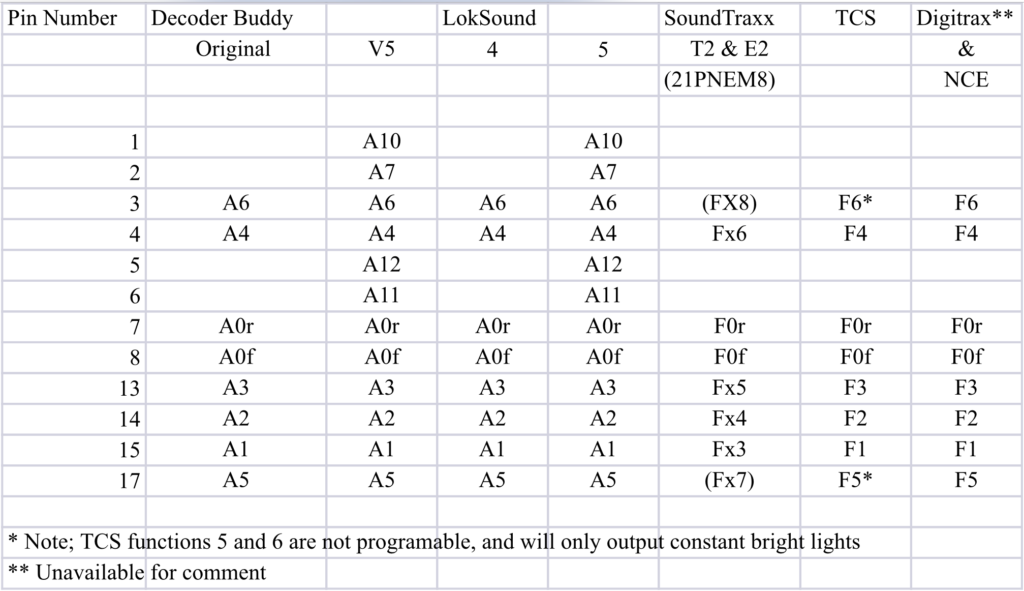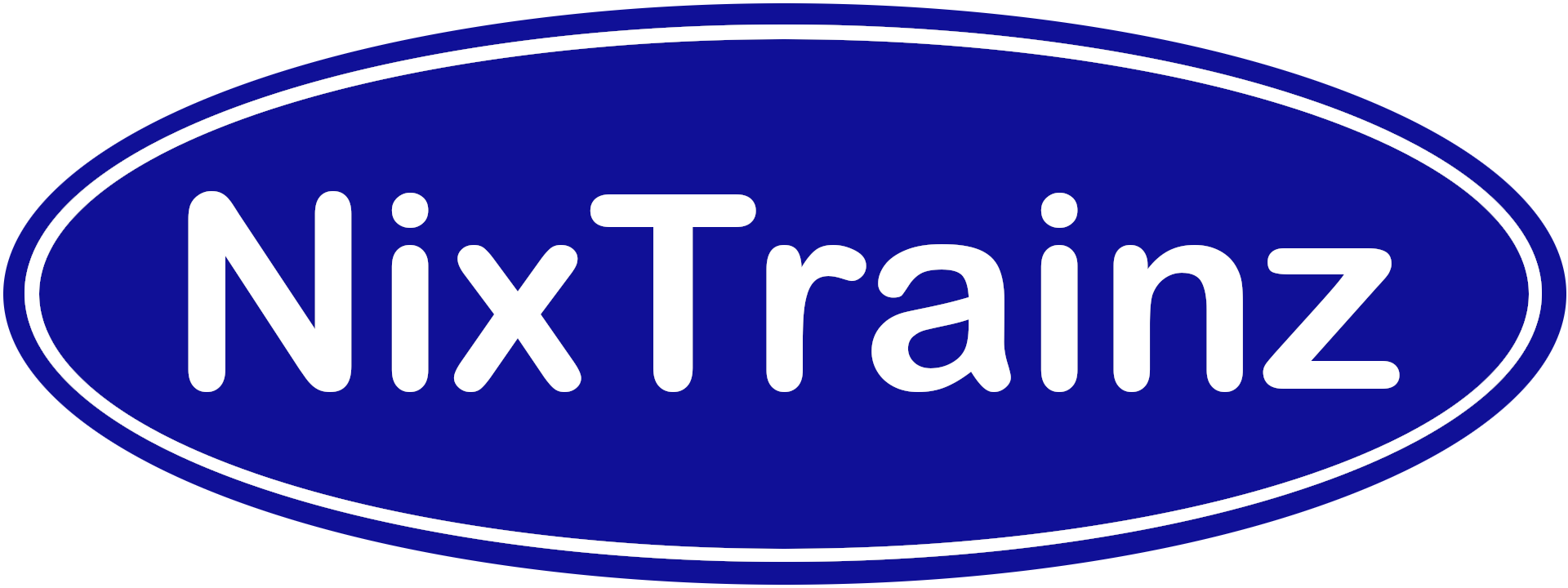Decoder Buddy V5 and V5B
The Decoder Buddy V5 and V5B were developed for the 12 output decoders and include a couple added features.
This mother board does not include the 21-Pin Decoder.
This mother board requires soldering.
This printed circuit board is NOT INTENDED FOR USE IN A DC SYSTEM. However, if the decoder you are using supports DC operation it should work.
The V5 and V5B come with standard 2.2K resistors onboard.
I can substitute / supply custom specified resistors for function outputs. These may be requested by the email link.
The mother board includes
- One 21 Pin Decoder receptacle
- Two pairs of track input pads
- One pair of motor input pads
- One set of stay alive pads (U+, GND on the V5. The V5B has the “W” pad for a Power Pack)
- Two pairs of speaker pads in parallel by side
- 12 lighting outputs on a separable “small connector board”
- Lighting outputs A11 and A12 are replicated on the “motherboard”
Resistors for use with LED lighting. The “0” ohm resistors accommodate previously installed LEDs with resistors in line and “12-volt LEDs”. It is IMPORTANT to realize that resistors must be used when LEDs are connected to the lighting outputs of the custom “0” Ohm boards!!!



The Original Decoder Buddy
The Decoder Buddy was developed for the 8 output decoders.
This mother board does not include the 21-Pin Decoder.
This mother board requires soldering.
This printed circuit board is NOT INTENDED FOR USE IN A DC SYSTEM. However, if the decoder you are using supports DC operation it should work.
The Original Decoder Buddies come with standard 1K resistors onboard. Some dealers also stock 2.2K original Decoder Buddys. The resistor values are printed on the packaging header in white circles.
I can substitute / supply custom specified resistors for function outputs. These may be requested by the email link.
The mother board includes:
- One 21 Pin Decoder receptacle
- Two pairs of track input pads
- One pair of motor input pads
- One set of stay alive pads, U+, GND. (The white wire from a Power Pack can be soldered onto the Original Decoder Buddy fairly easily)
- Two pairs of speaker pads in parallel by side
- 8 lighting outputs on a separable “small connector board”
Resistors for use with LED lighting. The “0” ohm resistors accommodate previously installed LEDs with resistors in line and “12-volt LEDs”. It is IMPORTANT to realize that resistors must be used when LEDs are connected to the lighting outputs of the custom “0” Ohm boards!!!
Decoder Buddy Mini
The Decoder Buddy Mini was developed to fit into smaller steam and diesel applications. There has also been interest in HOn3 and S-Gauge applications.
This mother board does not include the 21 Pin Decoder.
This mother board requires soldering.
This printed circuit board is NOT INTENDED FOR USE IN A DC SYSTEM. However, if the decoder you are using supports DC operation it should work.
The Mini comes with three different sets of standard resistors 2.2K, 1K and “0” Ohm. The dealers and distributors stock 1K versions unless otherwise stated.
I can substitute / supply custom specified resistors for function outputs. These may be requested by the email link.
The mother board includes:
- One 21 Pin Decoder receptacle
- Two pairs of track input pads
- One pair of motor output pads
- One set of stay alive pads (U+, GND and if necessary, a third control wire) If using an ESU ‘Power Pack’ we recommend A10 as mentioned below.
- Two logic outputs to control a Power Pack, smoke unit(s) or servo. The two logic output pads are 5 volt outputs with no resistors and controlled by A10 and A6 as labeled.
- One pair of speaker pads
- The correct headlight orientation is shown on the Mini.
Resistors for use with LED lighting. The “0” ohm resistors accommodate previously installed LEDs with resistors in line and “12-volt LEDs”. It is IMPORTANT to realize that resistors must be used when LEDs are connected to the four lighting outputs of the “0” Ohm or the Tiny!!! Resistors may be soldered in line when purchased or the included resistors may be soldered inline upon installation.
Resistors for use with incandescent bulb lighting. Remember there are different incandescent lamp voltage requirements and current draw that must be taken into consideration also. A single or two separate bulbs may work but multiple bulbs can be problematic. The “0” ohm resistors should provide the voltage and current necessary for incandescent bulbs. A ½ watt resistor at the very least should be used to reduce the voltage to the bulb and heat is a major consideration in this installation. I strongly recommend LEDs.
Resistors included on the Mini are standard and 1K. Values of the smd resistors appear in a white circle on the package for both standard smd resistor values.
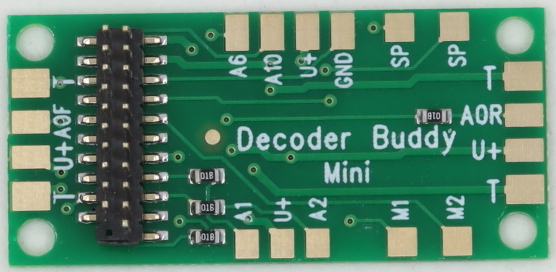
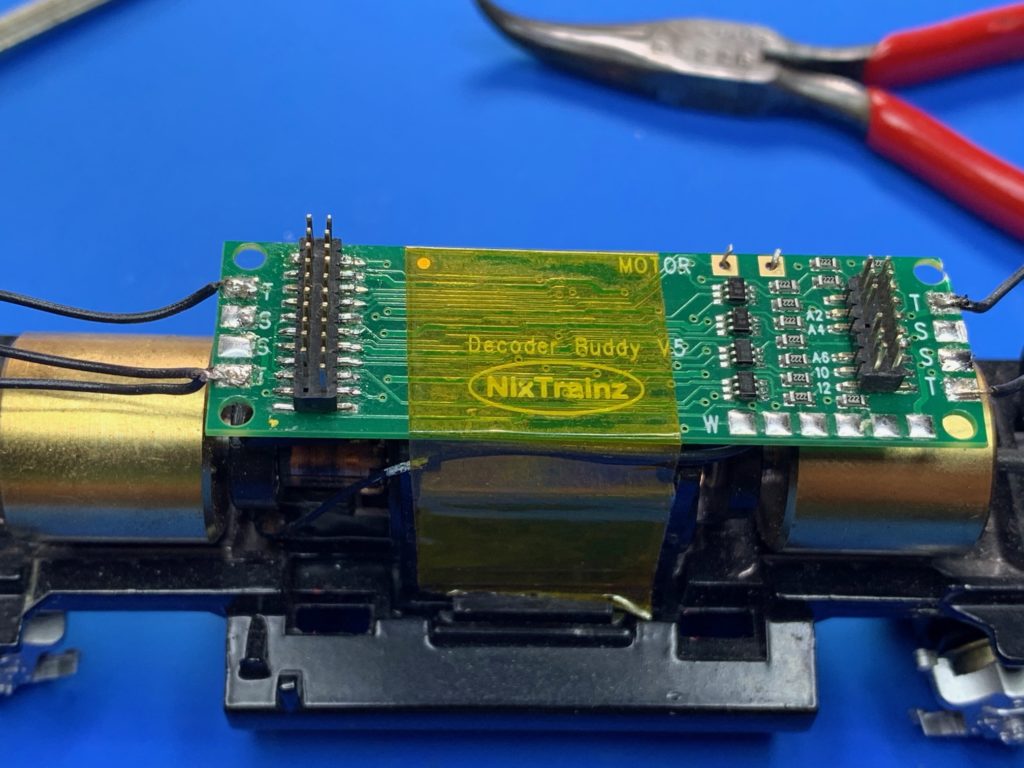
Original vs V5 Discussion
Manufacturer’s types of stay alives might well determine whether you want a two or three wire stay alive. The V5 has the capability of easily adding a two wire stay alive. The U+ and the GND pads are positioned close together and work well. The three wire stay alive or Power Pack has a third wire that could be connected to pin-1 on the base of the 21-pin connector. Pin -1 is associated with Aux 10 on a Loksound 5 decoder and used to turn the Power Pack off and on. It is used frequently but not as easy to solder to as a pad. I have a video on my Facebook page of the procedure.
The V5B has a dedicated pad for the white control wire of the Power Pack and is labeled “W”. Now there are six pads in the row of soldering pads on the bottom of the board just under the small light connector board in the picture on the right. They are, right to left; W, U+, GND, A12, A11 and U+. The other difference is that the “W” pad is connected to pin-2 of the 21-pin connector and the Aux 7 function controls the Power Pack on this board. It is the default function assigned to the LokSound 5 decoders.
You can use any 21-pin decoder in any Decoder Buddy.
All three are exactly the same size. You get to make the choice! Fortunately, all the Decoder Buddys have been accepted by both installers and modelers. They are being used in models of the blue box era to the latest releases from all the major manufacturers.
Hope this helps your decision…..
Light Test Board
With the abundance of lighting functions and wanting to see and check them before I placed the shell on the frame, I decided I needed a way to see what was happening! I went to work and prototyped a small connector board with LEDs so I could put the frame on the test track and test the motor, speaker and lighting functions before assembling the locomotive. The Light Test Board is also a good diagnostic tool to see if the decoder and motherboard are behaving properly!
The Light Test Board works with the 8 output Original Decoder Buddy, and both the 12 output V5 and V5B.
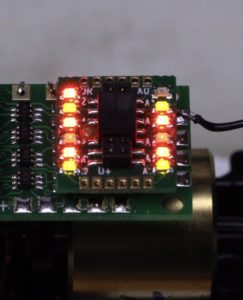
Decoder Buddy Sizes
Width x Length x Height
Original and V5 Mini
0.67” x 2.20” x 0.35” 0.65” x 1.35” x 0.35”
17 mm x 56 mm x 9 mm 17 mm x 35 mm x 9 mm
Height may vary slightly depending on decoder.
Minimum measured height is 0.35” by trimming the 21-pin connector pins flush with the top of the decoder‘s 21-pin connector.

Decoder Buddy solder pads for different manufacturer's 21 pin decoders
I’ve been getting a number of questions about the nomenclature on the pads of the small connector board. It is a little confusing at first. Here is a table that should straighten out the pad labels.
The first column has the pinouts from the 21-pin connector. The second column has the pad labels on the original Decoder Buddy’s small connector board. The third column has the pad labels on the V5 Decoder Buddy’s small connector board. The rest of the columns are the output labels of the different manufacturers 21-pin decoders. This chart should clear up any questions or confusion. If not, feel free to contact me
